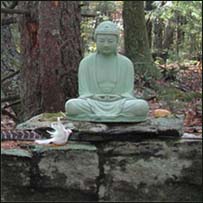|
|
 |
Please support Dharma Seed with a 2025 year-end gift.
Your donations allow us to offer these teachings online to all.

|

|

|
The greatest gift is the
gift of the teachings
|
|

|
| |
|
Dharma Talks
|
2024-12-06
Spiritual Joy
25:18
|
|
Ayya Medhanandi
|
|
|
Giving our full attention inwardly is waking up to the truth of pure presence. In one breath, one moment of pure awareness, we can know a spiritual joy that deeply calms the mind. The shutters of the heart open to a piercing clarity that cuts through the blinding deceptions of the world. Here in the silence at the very core of our being, we listen. The heart fills with joy and light, resplendent – just as the morning sun emerging from the horizon lights up the world. What we have been seeking far and wide is right here within us – seeing and knowing our true nature as it really is, we receive the gift of Unconditional Love
|
|
Sati Saraniya Hermitage
|
|
|
2024-12-05
Metta as Refuge
35:02
|
|
Leslie Booker
|
|
|
A response to where we are in this time in our history when everything might seem a bit topsy turvy and upside down. The political commentator Melissa Harris Perry refers to this kind of confusion as trying to stand up straight in a crooked room. Many of us have been secluding, isolating, putting up walls as armour, as protection - in order to not feel the full catastrophe. Many of us are here because we’re ready to lay that armour down, to engage with life and be alive again. And so this afternoons reflections will be on how we can rest in Metta as refuge.
|
|
Spirit Rock Meditation Center
:
In the Presence of Love: A Mettā & Qigong Retreat
|
|
|
2024-11-27
Heart Meditation: Taking in the Goodness
24:12
|
|
Tara Brach
|
|
|
Taking in the Goodness: Rumi said, “Whenever some kindness comes to you, turn that way – toward the source of kindness.” This meditation guides us to look for the source of loving and to turn in that direction. It begins with a lovingkindness practice that spreads the image of a smile into the body, then continues with a practice of seeing the goodness of ourselves and others.
Then it was as if I suddenly saw the secret beauty of their hearts, the depths of their hearts where neither sin nor desire nor self-knowledge can reach, the core of their reality, the person that each one is in God’s eyes. If only they could all see themselves as they really are. - Thomas Merton
|
|
Insight Meditation Community of Washington DC
|
|
|
2024-11-27
Gratitude: Entering Sacred Relationship
52:35
|
|
Tara Brach
|
|
|
Gratitude arises when we are in sacred relationship with life—present, open and receptive. This talk explores how central gratitude is to our physical, emotional and spiritual wellbeing, and then looks at the ways we can directly gladden our minds with gratitude. We end with a guided meditation that includes sharings from the group. The audio includes a poem of blessing by John O’Donohue with a brief cut from Robert Gass – Om Namaha Shivaya (from the archives).
|
|
Insight Meditation Community of Washington DC
|
|
|
|
|